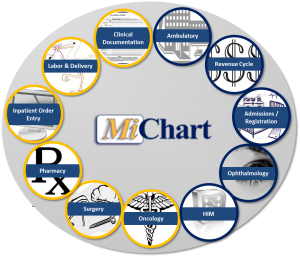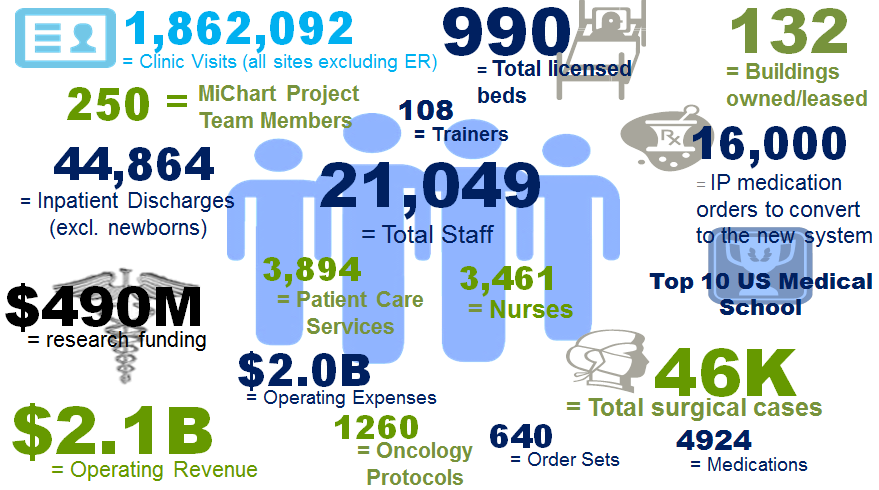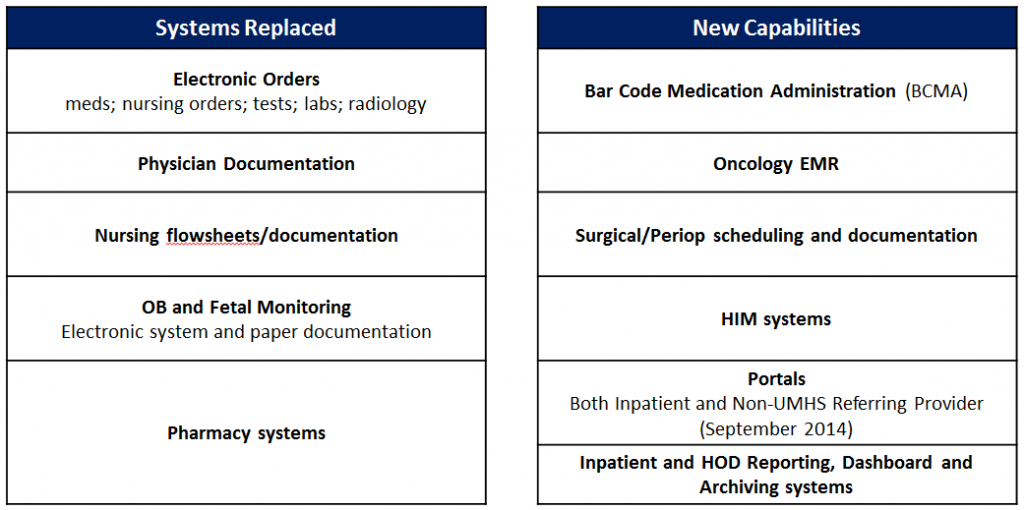Walking down the hall at our University Hospital last week, I ran into a UMHS senior leader I hadn’t seen in weeks.  He asked me how MiChart was going – that’s the program name for our new integrated electronic health record. I said “very well.” I joked there are no picket lines outside my office and I’m not getting nastygram emails. I’m actually getting to focus on a lot of other things now, compared to those first few weeks after our MiChart Stage 3 inpatient go live two months ago. Our clinicians and other staff are adapting pretty well and, overall, things are going smoothly.
He asked me how MiChart was going – that’s the program name for our new integrated electronic health record. I said “very well.” I joked there are no picket lines outside my office and I’m not getting nastygram emails. I’m actually getting to focus on a lot of other things now, compared to those first few weeks after our MiChart Stage 3 inpatient go live two months ago. Our clinicians and other staff are adapting pretty well and, overall, things are going smoothly.
With this stage of our Epic implementation completed, we now have an integrated system across ambulatory, inpatient, hospital outpatient departments, and revenue cycle.
It has been no small feat for an organization of our size and complexity.
In my first blog post early June, “Three Days and Counting”, I talked about the preparations for our go live. Here are some key statistics to give a sense of scale for that implementation:
- 900 inpatients during the cutover
- 42,800 orders converted by 425 providers, pharmacists, nurses, and staff
- 2700 oncology protocols (complex order sets) – the most built/converted for a go live in the history of Epic!
- 700+ order sets, 7000 customized medication orders, 6500 surgical preference cards, and 12,000 flowsheet rows.
- 35+ interfaces
- 287 reports
- 16 Web services to 30+ applications
- 700+ monitors, 300+ ventilators, and 1700+ barcode medication administration (BCMA) scanners
- 14,000 faculty/staff trained, 111 courses created, 3140 individual classes conducted, 108 trainers
I said then it takes a village and it did! It was the combined effort of our IT staff, our clinicians and operational leaders that made it a success.
Our MiChart Stage 3 implementation replaced several disparate inpatient systems and added new capabilities:
Shortly after our successful go live in June, I identified four parallel tracks for MiChart going forward:
- Stabilization and optimization – We are still in the “stabilization” phase though we are already dealing with many “optimization” requests. Service desk calls and tickets continue to come in as users get more familiar with the system and submit new requests. Project leadership is focused on addressing integrated workflow issues and managing the prioritization process for optimization requests.
- Stage 4 – Our roadmap calls for a fully integrated electronic health record. The next stage will potentially include anesthesiology, radiology, cardiology, transplant and home care. We are in the planning and scoping phase now. Working closely with these areas and senior leadership, we hope to decide what will be included by the end of September.
- Strategic use and fully leveraging MiChart – We have much to learn from the many organizations that are further along on their Epic journey. We want to complete the work to reach Level 7 (or Stage 7) of the HIMSS EMR Adoption Model (EMRAM). As a result of our inpatient implementation, we have achieved Stage 6. 15% of the hospitals in the U.S are at Stage 6 and only 3.2% of hospitals have achieved Stage 7. We hope to join this even more advanced group soon.
- Affiliates – As UMHS develops affiliations with other organizations in our region, we need to share data to support transitions of care. There are a range of options depending on the type of affiliation and specific needs.
I’m happy to say that we are making progress on all four tracks. And there has even been time for people to take some much needed vacation this summer!
Since June, we hosted a group from Great Britain who wanted to learn from our experiences. We are in the early planning phase for a few other site visits. We will continue to learn from others and to teach others when we can.
Our work continues. We are making a difference!



Mike Davis on said:
Sue, how did the RCM conversion go? Did the AR days spike? I’d love some insights into that area if you can provide them.
Sue Schade on said:
Mike, revenue cycle was early 2012 before my time. I’ll see if I can get some info to share with you.
Marian Mueller on said:
I like hearing your views from the top. Sometimes it is hard to see the big picture when muddling among the mire.
Sue Schade on said:
Marian, thanks for the feedback and all your efforts to make MiChart a success!
Mike Davis on said:
Thank you! You appear to have avoided the big Gremlins that some organizations have run into with Epic. Nice work!
Melissa Manley on said:
Day one of a true vacation and I just read your blog. Just now did I fully appreciate all the moving parts that made our transition a success. As we continue on the journey, I will remember the importance in interdisciplinary teamwork!! Thanks for sharing!
Sue Schade on said:
Melissa, the interdisciplinary teamwork and problem solving was definitely one of the most impressive parts of the project.